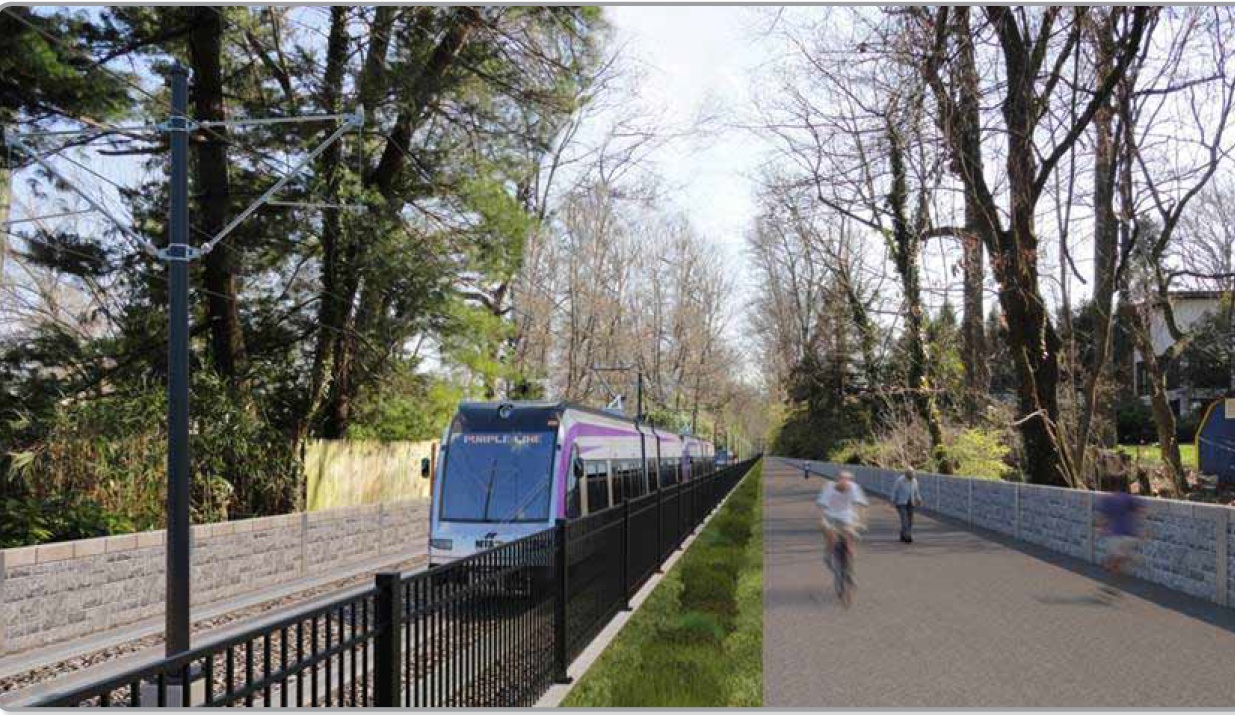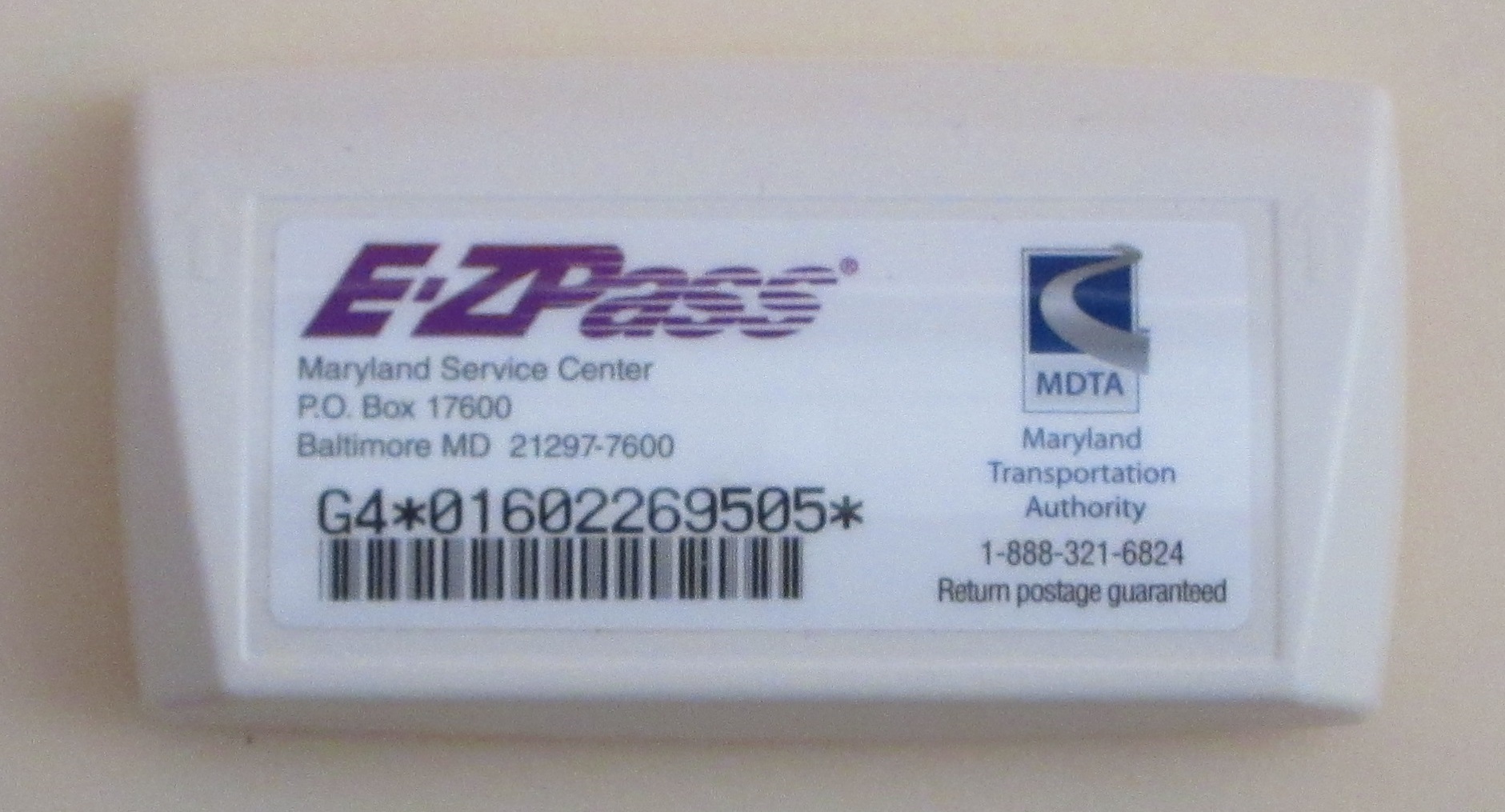Artist rendering above: Purple Line trains plan to run along Capital Crescent Trail.
Editor’s Note: This is the second of two stories about whether Gov.-elect Larry Hogan will choose to move forward on one of the most major transportation projects being proposed in the state, the 16-mile light rail Purple Line in Prince George’s and Montgomery counties. Our first piece examined the benefits to the project; this story examines some of the concerns with the $2.4 billion proposal.
By Glynis Kazanjian
Moving forward on the Purple Line would be a major financial commitment for Republican Gov.-elect Larry Hogan, who has at times been harshly critical of the project.
Hogan has not decided if he will support its construction, and has somewhat tempered his criticism. Yesterday he appointed as his transportation secretary Peter Rahn, former head of transportation for the states of Missouri and New Mexico. Hogan pointed out that Rahn’s reputation as a highway builder was a factor in his selection.
To help pay for the $2.4 billion project, Maryland officials are expecting the federal government to contribute $900 million in federal transportation grants over a period of nine years beginning in 2015.
However, none of the federal dollars are guaranteed until a multi-year funding contract is signed off on between state and federal officials. That is slated to occur this spring, after the state has selected its private project partner to help design and build, then operate and maintain the Purple Line.
The balance — $1.5 billion — would be covered using approximately $711 million in allocated state funds, a private project partner that would finance up to $900 million for the state, and Montgomery and Prince George’s counties that would each kick in $120 million.
Cost has risen by about $300 million
The project’s cost has increased nearly $300 million since November 2012, according to Federal Transportation Administration reports. Henry Kay, executive director for Transit Development and Delivery for the Maryland Transit Administration (MTA), said increased property values and interest on financing drove the cost upwards. Many believe the cost could still increase.
“We simply cannot afford this project right now,” Hogan stated in an Oct. 16 press release. “… The cost to individual taxpayers comes to about $850 for every income tax return filed by Maryland residents – a hit that many simply cannot afford to take after 40 consecutive that hit working- and middle-class families the hardest.”
To date, the state has invested $187 million on the project for planning including evaluating alternative paths, engineering and buying rights of way, according to MTA.
Opponents say:
- Building the Purple Line, which will be funded by the state’s Transportation Trust Fund (TTF), would prohibit consideration of any other new transportation projects for six to 10 years;
- Using a private project partner to finance between $600 million and $900 million of the project will significantly increase the cost for the state. The state has narrowed potential partners to a short list, but hasn’t selected a final company. Despite some beliefs the private partner is contributing the money, all of it will have to repaid in full by state taxpayers over a 30-year contract period. Current projections indicate the state will be responsible for between $100 million and $200 million annually, every year for 30 years. It is estimated the operating costs alone will be approximately $40 million per year;
- The amount of transportation revenue coming in is declining. Staff from the Department of Legislative Services (DLS) indicates there will be an estimated $400 million shortfall in projected TTF revenue for the period of fiscal years 2015 through 2020. A final report – the Consolidated Transportation Program plan – will be released Jan. 23. DLS staff said lower gas prices are a big part of the revenue decline, along with a change in driving habits. In 2013 the state passed a gasoline tax as a major revenue source for the TTF;
- Questions persist about projected ridership numbers that, among other things, will forecast projected revenues that the state will need to cover some of the long-term operating costs of the project. To date, fares have not been determined, but Kay said the state is considering a range that would be between Metrobus and Metrorail fares.
- The state debt level could be affected by the private financing. DLS analysts indicate MDOT has stated the debt incurred by private financing to construct the Purple Line should be categorized as non-traditional debt (as opposed to state tax-supported debt) because Purple Line fare revenues would be pledged to the 30-year debt service payments, and if the revenues can’t cover the debt payments, then all MTA fares would be pledged.
- Residents and businesses will be displaced. Fifty-six residences and 88 businesses will need to move, Kay said. Any relocation by the state would trigger relocation benefits, and if the state cannot reach amicable settlement with property owners, it has the option to use eminent domain.
- Building the Purple Line is an “environmental disaster,” Hogan has said, according to an Oct. 16 fact sheet. A Montgomery County non-profit group filed suit against the Federal Transit Administration, the U.S. Fish and Wildlife Service and the Secretaries of Interior and Transportation last August. Natural habitats in the Rock Creek watershed would be disrupted, nearly 50 acres of trees would be cleared on the Capital Crescent Trail hiker/biker trail and noise and vibrations from the train are concerns.
Madaleno, other leaders skeptical
Sen. Richard Madaleno, D-Montgomery, the new vice-chair of the Budget and Taxation Committee, considers himself a “skeptic” when it comes to the Purple Line.
When asked if he considered the Purple Line a priority project for the state or one that could wait, he said he just didn’t know if the economics of the project would work any longer.
“With the revenue package passed two years ago [which is] projected forward, there are question marks about how much revenue will come in,” Madaleno said in an interview. “If revenues hold, you can afford to build both transit lines, but you really can’t build anything else new for a six to 10 year period. All the new construction money would go towards the two big transit projects. There still would be money for maintaining the current road structure, but you’re not going to have widenings or new roads or 270 widened from Germantown to Frederick – all those sorts of projects would be put on hold.”
Madaleno also said he tried to gain “additional information” on the financing plans, but MTA officials first asked him to sign a confidentiality agreement. Madaleno said he was hesitant to sign it and didn’t.
“How they arrive at those projections are trade secrets of the consultants,” Madaleno said of the ridership numbers. “Because they won’t share how the numbers were arrived at because it is developed using a proprietary analysis system owned by one of the contractors, you don’t know how to judge — you’re at a loss.”
Referencing Barry Rascovar’s Maryland Reporter column, Madaleno said he disagreed that traffic would be taken off the beltway.
“This does nothing to reduce traffic,” Madaleno said. “What it does is provide the opportunity for different growth to occur.”
Activists concerned about ridership secrecy
David Lublin, the former mayor of Chevy Chase and chief blogger of Seventh State, has done a series on the Purple Line called, “The Giant Purple Credit Card.” Lublin said there are multiple cons to building the Purple Line.
“First it is being touted as an environmental project, but it’s not,” Lublin said. “It’ll actually use more energy than it will take off the road. The people forget the electricity to run these things has to be produced and producing it will create more greenhouse gases than if we just had cars. Versus, if you did it as a bus rapid transit, particularly if you did it as a natural gas, it would be much more environmentally friendly.”
Lublin also said he thought the ridership numbers have been kept “very secret from the public.”
Purple Line studies indicate only 11% of residents within the proposed corridor currently use public transportation. Kay said once the Purple Line is in use, that percentage is not likely to go up that much.
“If that’s your measure, probably not much,” Kay said. “As a percentage of overall travel it’s not going to move that needle that much.”
Hogan will have to determine priorities
“Our two biggest transit priorities should be making sure the system we have now is fully functional,” Madaleno said. “It doesn’t make sense to me to be building a vacation home if you’re regular home is falling apart. The second is providing transit opportunities to more people who don’t have access to transit.”
According to Erin Henson, communications director for MDOT: “In the current draft six-year Consolidated Transportation Program (CTP) for FY 2015 to FY 2020, there are approximately 1,600 projects with the vast majority funded for one or more phases, such as planning, design and construction. The draft program includes $15.9 billion in fully funded investments in Maryland’s transportation network paid for by the Transportation Trust Fund.”
Madaleno said, “If the Hogan administration has different priorities for projects, I don’t think there are the resources to accommodate both his priorities, as well as the priorities he will be inheriting.”
Reports:
Purple Line Travel Forecasts Technical Report, August 2013







Is there anyone who really thinks this $2.4 BILLION project will come in under $4.2 Billion?
Assuming the Purple Line is a “transit” initiative, taxpayers need to be very afraid. Witness the Silver Spring TRANSIT Center both late and over budget.
It is time to ditch the PL in favor of better transit projects that actually relieve congestion rather than spur development. Perhaps saner minds will prevail.